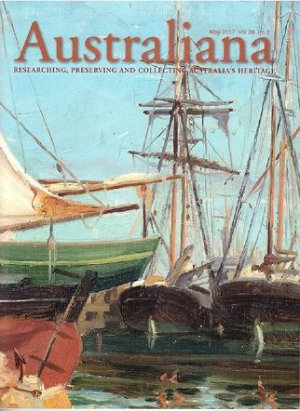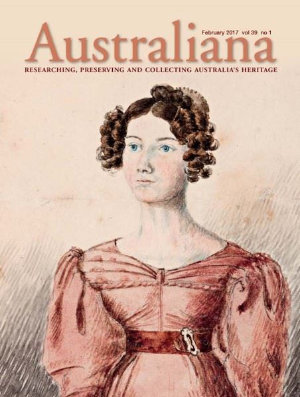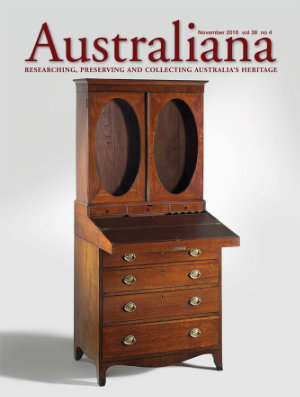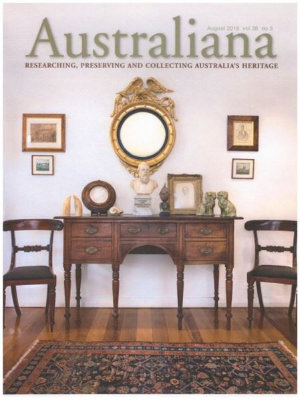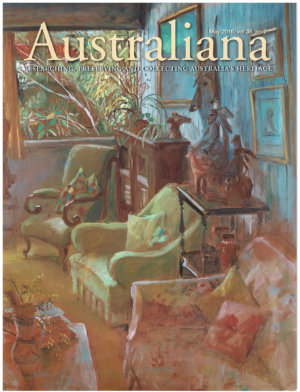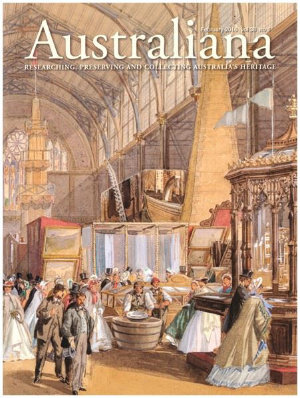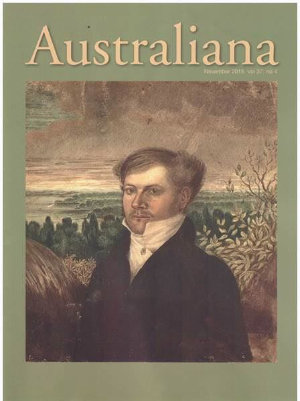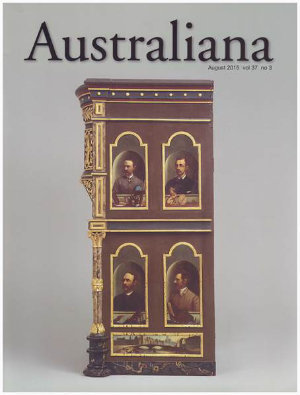Trevor Kennedy AM has always been larger than life than most people, both in his business career and now his eclectic Australiana collection. Born and educated in Western Australia, he became a prominent Australian journalist, businessman and company director, serving on many company boards. As a journalist Tre...
Australia’s first agricultural society was founded 195 years ago, to organise shows and encourage better farming practices. They are still going strong, and even today agricultural shows attract a lot of interest in the cities, with millions visiting across the nation. For those on the land, they are much mor...
The works of Elizabeth Hudspeth are largely unknown, like those of many early Australian women artists. Robert Stevens remedies this, and illustrates some of her works which have been rarely or never published nor seen. Her sketches of some early Tasmanian buildings, which have since been destroyed, may be the ...
Religion was much more prominent and pervasive in 19th-century Australia than it is today, and South Australia was more tolerant of all sects than the other colonies. Peter Lane discusses the foundation scroll laid by Governor Gawler for Adelaide’s Wesleyan Methodist Chapel, constructed less than two years af...
I started at the Queensland Art Gallery as the first Curator of Decorative Arts in 1981 ‘wet behind my (curatorial) ears’. The first project I initiated, LJ Harvey & his School, opened in September 1983, following the relocation of the Gallery’s collection to its new building on the south bank of the Bris...
It is timely to showcase the lively drawings of an Australian on the Western Front in the Great War 100 years ago. Although the young man fought in those terrible trenches, most of his images have a quiet dignity. Only in the heat of a battle in which he was wounded, do you feel the horror of it all; his franti...
The Peter Walker Fine Art Writing Award is an annual award generously sponsored by Peter Walker Fine Art of Walkerville, South Australia. Peter Walker is a valued member and longstanding supporter of the Australiana Society. The Society is most grateful for his continued interest in its activities, and in the j...
The Australiana Society is delighted to report that the new Tasmanian Chapter held its inaugural event on 11 November 2016. Since the foundation of the Australiana Society in 1978, members have believed that Tasmaniana was of sufficient importance, quality and difference to that of mainland Australia to warrant...
The English sculptor Thomas Woolner sailed out to Victoria in 1852 to search for gold. Like many others who failed to strike it rich, he returned to his earlier profession. Woolner created a series of portraits of prominent colonials in Melbourne and Sydney before returning to England in 1854; most are well kno...
How do three spoons, two by Sydney silversmith Alexander Dick and a later spoon made in London, come to bear the same crest and initials? Lesley Garrett explores the possibilities.
How things are designed and made should interest all those with a passion for the creative arts. One of our members, Christine Erratt, was involved in the process of designing a new mace for the Australian Catholic University because of the important articles she wrote for Australiana, and another member, W.J. ...
By examining the innovations in the various editions of the London and Edinburgh cabinet-makers’ books of prices, as well as identifying the decorative details favoured by Irish cabinet-makers, John Hawkins suggests that it is possible to develop a chronology for the important group of early Sydney furniture ...
Many fields of collecting remain undocumented in Australiana, despite nearly 40 years of publication. Australian toys are just one area that has been neglected and under-researched. Children grow up and usually grow out of their children’s toys. Their toys – especially soft toys and books – often get dog-...
Those familiar with the capital of New South Wales will know George Street, Sydney Cove and The Rocks. Karen Eaton deconstructs John Carmichael’s engraving George Street from the Wharf and explores in detail its five main elements – George Street, the King’s Wharf, the Commissariat Stores, Kemp & Dobson�...
We are so lucky to have such a beloved, wonderful and extraordinary uncle, brother, great uncle and, of course, friend! Our family are all so touched that the Australiana Society has honoured Kev in this way and we are sure that watching over us this evening he is thrilled! You call him Kevin Fahy AM ... but we...
Len Peterson (1904–1981) began working at Adelaide jewellers S. Schlank & Co in 1919, and was closely associated with them until they closed in 1970. This is an edited version of his reminiscences, compiled between 1976 and 1980 for the Goldsmiths Guild of SA, giving an insight into the 20th-century Australia...
The idea of an annual series of lectures named after Kevin Fahy came from our secretary, Michael Lech. The obvious subject for the first, held in Sydney on 12 March, was Kevin himself. Australiana editor and foundation member John Wade chose to talk about him as a friend, patriarch, storyteller and scholar, to ...
The Queen Victoria Museum and Art Gallery in Launceston claims that Peddle chairs are “Tasmania’s best known antique”, so that probably justifies a book about them. And who better to compile it than Denis Lake, a Launceston furniture restorer, who can combine research with his detailed practical knowledge...
The much-loved artist Margaret Olley is commemorated in the Tweed Regional Art Gallery at Murwillumbah, which established the Margaret Olley Art Centre and displays some of her paintings and her re-created studio. Glenn Cooke is adding his personal tribute to Olley, in the form of an illustrated database of Oll...
Jewellery dealer Anne Schofield, who performed the official opening of the exhibition Bling: 19th century goldfields jewellery at the Museum of Australian Democracy at Ballarat on 16 April, kindly let us publish her address.
Trove and family histories have recently revealed information about Edwin Foss Duffield (1846–1922), a colonial-born craftsman of distinction in Western Australia. He commenced working in Fremantle in the late 1860s as a cabinet maker and undertaker, and a number of pieces of furniture from his workshop survi...
The John Oxley Library at the State Library of Queensland has added a portrait of Lord Lamington, Queensland’s eighth governor, to its collection of historical works of art.
Jolyon Warwick James traces the story of an Australian colonial silver spoon with a name engraved on the stem, and finds a link with a banker who lived and died at Bronte House overlooking one of Sydney’s famous beaches.
George Richard Addis (1864–1937) is best known as one of Western Australia’s leading late 19th- and early 20th-century goldfields jewellers, whose Western Australian work has been documented by Dorothy Erickson.1 Many jewellers however worked in different colonies, and here Michel Reymond records for the fi...
Since opening an art gallery last year that includes a display of early cedar furniture, Bob Fredman has been fascinated to see that the furniture strikes a strong chord with nearly all visitors. They unfailingly comment on it being beautiful, and especially take an interest when they find out it is all Austral...
In our May 2015 issue, Dianne Byrne identified a brooch presented in 1867 to Lady Bowen, wife of Queensland’s first Governor, in a photograph held in the National Library. Further detective work has revealed that the brooch is still held by Lady Bowen’s descendants in England. We illustrate it now for the f...
Dorothy Erickson documents the life and work of Mattie Furphy (1878–1948), a Victorian who moved to Perth in 1902 to become a prominent Western Australian artist and designer.
Seldom do prisoner of war trench art objects indicate where they were made. One that does is carved from wood in the shape of continental Australia, with the words and date “Murchison den [the] 24.8.1941” together with a stylised Australian coat of arms.
During the second decade of the new millennium, many pioneers of the crafts movement in Australia, which began to flourish in the 1970s, will celebrate four decades of working in studio practices with their chosen materials.
Prestigious Melbourne cabinet maker Geo. Thwaites & Son operated from 1842 to 1889, providing high-class furniture for Victoria’s mansions, homesteads and prominent institutional and public buildings. Today the firm is best remembered for its contracts to furnish Government House in 1854 and again in 1875 and...
The National Gallery of Australia holds a three-piece silver buckle that originally formed the central element of a Champion’s Boxing Belt presented to prize-fighter Isaac Reid in 1847 (plate 1). This remarkable belt was made by Sydney silversmiths J.J. Cohen & Son1 and engraved by John Carmichael. Until rece...
Dr Annette Gero’s article “Wartime quilts” in the May 2015 Australiana stimulated Peter Lane to contact her about an Anglo-Boer War keepsake. Trooper Ernest Worrall of South Australia had drawn images and words on this rather small scrap of khaki fabric in 1902. Mementoes of that war are rare and Dr Gero ...
Samuel Thomas Gill died melodramatically, aged 62, on the steps on the Melbourne Post Office at half past four on Wednesday 27 October 1880. A policeman recorded that he “was in a most filthy state and covered with vermin” while a search of the pockets found pills which identified him. An autopsy revealed t...
Edinburgh-born John Carmichael arrived in Sydney in 1825, living and working there for over 30 years producing landscapes, portraits, maps, billheads, musical scores, illustrations and some of Australia’s first postage stamps. His works provide a revealing and valuable record of life and times in colonial Syd...
The extended title for this splendid visual feast is a catalogue to accompany the exhibition Postcards from the Edge of the City at the Santos Museum of Economic Botany, 9 December 2014 to 26 April 2015. As a catalogue this book contains the front and back sides of 300 postcards published between 1900 and 1917.
Museums tend to lift items out of the ordinary world into the refined orbit of curators. In detailing the history of a collection of Krimper furniture bought by a Sydney family, Catriona Quinn shows the importance of knowing the history of an object, its owners and context – its provenance – and argues that...
Australiana Society members were privileged to see, touch and experience many and varied treasures on our Tasmanian tour. Here we showcase the welcome and rare opportunities extended to those who participated, and encourage other members to consider creating a future tour showcasing your state or region, offeri...
Published as the first of two hardcover volumes (the second will cover the period from 1950 to now), this is Dr Dorothy Erickson’s most ambitious publishing venture. Exploring the work of designers and makers in Western Australia since the founding of the Swan River Colony in 1829 until 1969, it is her most s...
Over the last 20 years or so interest in convict artist Joseph Lycett (1775–1828) has steadily quickened and heightened in Australian popular culture through the influence of various published works and exhibitions. He is now held in high regard by art and cultural historians.
R.B. Smith made his model of the Strasburg Clock to celebrate the centenary of British settlement. It was hailed as a “scientific triumph of Australian workmanship”. At first, Smith exhibited it privately “like a fat woman in a country fair”1 until it found a home in Sydney’s Technological Museum. The...
Cricket is in the news with the Ashes being played in England. Sir Donald Bradman (1908–2001) is respected as the world’s best and most famous cricketer, both in Australia and the United Kingdom. His grandfather, Charles Bradman, lived in the small Suffolk village of Withersfield until he emigrated to Austr...
In the 19th century, an appropriately draped “chair of state” under a canopy was deployed on formal occasions when the monarch or her vice-regal representative was present. These chairs were conspicuously larger than any surrounding chairs, acknowledging the status of the occupant. Dr La Nauze traces the hi...
Hordern House continues their excellent service in the publication of early colonial history by releasing Robert Purdie’s Narrative of the Wreck of HMS Porpoise hot on the heels of Elizabeth Ellis’s book on The Sydney Punchbowl in the Mitchell Library. Here the subject is a first-hand description of the fou...
